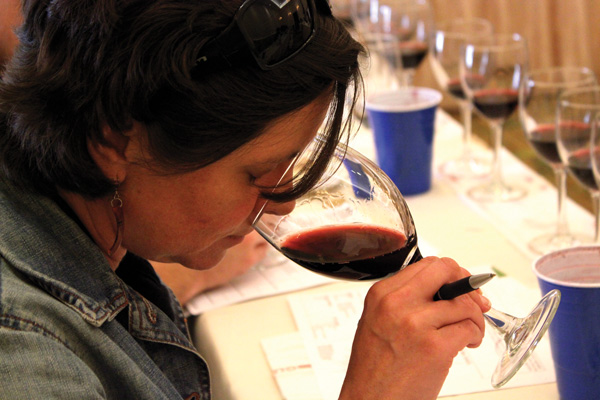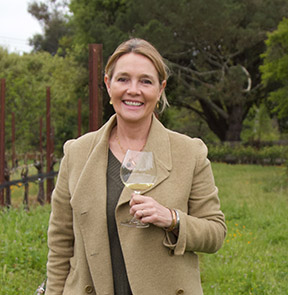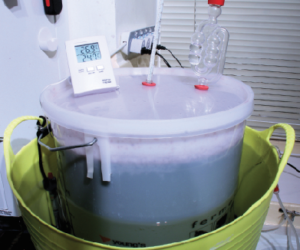Many feel that volatile acidity (VA) in wine is a blessing and a curse, however, it is only a blessing when you cannot distinctly smell it! All wines have some level of VA, although it is usually below the sensory threshold level (lowest concentration a compound can be perceived by humans). When below sensory threshold levels, it can give a wine “lift” and tweak the tone of aromas in a wine, often making it more lively, perhaps more complex. This is a commonly accepted, but somewhat controversial stance and some feel the lower its presence the better . . . period. When at or slightly above threshold, in my experience, VA can add interesting spice and fruit character, primarily in reds. But, once VA levels are firmly into the sensory perception range, a wine is scarred with vinegar or nail polish remover aromas. Let’s look at what VA is, how it happens, and how to avoid perceptible levels.
While the most common defect I’ve seen in home winemaking competitions is oxidation, in professional wines, volatile acidity is by far the most common. VA in wine today is usually found in wines from younger, “natural” winemakers. It has become a hallmark of the natural wine movement to the extent that many consumers have come to enjoy it. I think a wine should tell the story of the grapes it is made from, and defects like VA resulting from poor winemaking habits serve only to censor that story.
VA can come from any microbe in wine (including the ubiquitous Saccharomyces and Oenococcus), but the most critical producers when it comes to perceptible defects are various species from the “acetic acid bacteria” genera Acetobacter and Gluconobacter. Acetobacter feeds on ethanol and Gluconobacter prefers to feed on glucose. VA can also result from various lactic acid bacteria. Acetic acid bacteria are present on all grapes and in all wines, our job is to inhibit their growth and minimize their populations.
Acetic acid bacteria is in your wine at all times, waiting for oxygen to be able to grow, multiply, and metabolize, raising your VA levels.
VA can refer to two defects in wine, acetic acid (vinegar) and ethyl acetate (nail polish remover — which, fortunately, is harmless at the concentrations found in wine). Acetic acid bacteria metabolize alcohol or sugar into acetic acid and in low oxygen conditions, usually early in fermentation, this acetic acid can be turned into an ester to form ethyl acetate.
As acetic acid is produced by Saccharomyces yeast and lactic acid bacteria, even in clean wines, it is present at around 0.36–0.48 g/L, increasing slightly during aging — as the wine is exposed to oxygen, which acetic acid bacteria require.1 Acetic acid has a sensory threshold of between 0.6 and 0.9 g/L (depending on the wine and the taster’s sensitivity to it).2 Ethyl acetate is perceptible at much lower levels, 150–200 mg/L, again depending on the wine and taster (it’s potent stuff!).3
Most countries have legal limits for acetic acid concentration for wines to carry regional designations, usually between 1.07 and 1.5 g/L. Less is permissible for whites than reds, as it is more problematic for wine character in whites.2 At these levels, it will be easily perceptible in most wines.
When does VA occur and what can we do to stop it?
IN THE VINEYARD
Damaged or diseased fruit can result in VA. When fruit is damaged by pests or disease and the skin is ruptured, fermentation happens in the grape itself, which eventually is converted by the grape’s acetic acid bacteria into volatile acidity. Next time you see a bird-damaged grape, give it a smell — most will have a vinegar-y aroma. This damaged fruit harbors much larger populations of acetic acid bacteria than sound fruit, which, if not sorted out, will start your fermentation off with a higher risk for problems. If you do have some damaged or diseased fruit, be sure to dose your must with SO2 (0.5 molecular SO2) prior to fermentation.
CHEMISTRY
Lower pH in wine is an inhibitor of all problematic microbes; by itself, as well as by increasing the portion of active SO2 in the wine. Wines with a pH lower than 3.6 are considered at lower risk for microbial spoilage. Keep in mind that if you want to have a finished wine with a pH higher than 3.6, if allowing malolactic fermentation to happen, your wine’s pH may be lower than 3.6 during alcoholic fermentation. This helps offset higher pH wine’s risk to some degree, at least earlier in the wine’s life.
ALCOHOLIC FERMENTATION
Fermentation is the primary period where VA problems arise. Acetic acid bacteria are aerobic bacteria, and therefore need oxygen to function (and produce VA). Once a fermentation is going strong and producing significant amounts of CO2 — which blows off oxygen and blankets the cap — VA risk is significantly reduced.
Before fermentation starts, or while it’s picking up steam, is when acetic acid bacteria are usually at their happiest. It’s common to smell some acetic acid or ethyl acetate at this point, and it’s usually not cause for concern — again, all wine has some VA and a little dollop may be a good thing. That said, it’s not something you want to let get out of control and you should take steps to mitigate it. Acetic acid bacteria produce substances that can inhibit yeast, and acetic acid itself may be toxic to yeast, so you run the risk of a stuck fermentation, which in turn puts you at a high risk for further VA production.2 What do you do to inhibit acetic acid bacteria at this stage? Here are some pointers for winemakers:
Temperature Control
Keep your must cold early on. This is one of the key reasons many grapes are picked at night or that musts are cooled down. As bacteria is inhibited at warmer temperatures than yeasts, having your must at around 50–60 °F (10–15 °C) while fermentation is starting gives your yeast time to multiply and start working, while at the same time inhibiting bacteria. Once fermentation has kicked off and CO2 is being produced, fermentation temperature becomes more of a stylistic consideration. If your grapes come in warm, you can always cool down your must after crushing/pressing. Dry ice works or you can buy a small glycol chiller (I have one I love — see page 53 for some available small-scale hobbyist models) and cooling plate (starting at $200 at winemaking suppliers). This same setup can later be used to keep fermentations cool and to cold-stabilize whites.
Oxygen Control
Blanket your must with CO2 or argon. Before a fermentation is producing significant CO2 levels of its own, you can sparge the headspace in your fermenter with carbon dioxide or argon gas. Be sure to use a plastic or impermeable cover at this point, as oxygen will diffuse in through cloth a lot faster. CO2 and argon are heavier than oxygen, so they help create a “blanket” over the must. Nitrogen isn’t useful here, as it is lighter than oxygen. The CO2 or argon blanket is imperfect and temperature differences will create convective currents further hastening the demise of the “blanket,” but it still makes a huge difference compared to not sparging at all. Argon is superior, being heavier than carbon dioxide, but it is also much more expensive. Sparge your headspace every time you punch down/pump over, or open the fermenter cover. Once fermentation is going strong, you can switch to a cloth cover, if you like (which helps dissipate heat and a bit of alcohol).
Cap Management
Punching down/pumping over on reds is your responsibility and needs to happen regularly. Acetic acid bacteria will only grow where there is oxygen, pushing them back down into the must puts them in a hostile environment, so the act of simply punching down or pumping over is a good way to discourage VA. If you have a healthy fermentation and are not smelling VA, only one punch down/pump over per day is really necessary to keep the cap wet and submerge populations. If you are smelling VA in between punch downs/pump overs, increase their frequency to two times per day or more until this ceases to occur. You may of course want to punch down/pump over more frequently for stylistic reasons or to help dissipate heat.

Press Cuts
One important facet to understand is that press wine has a higher concentration of VA than free run. If your wine smells of VA by the time fermentation has finished and you are concerned, consider keeping your free and press run wine separate for a bit. In the event that your free run seems OK but the press run is volatile (which would mean you luck out that the free run remains under threshold and the press run not), don’t blend them together and be extra diligent during aging (more on that later).
Commercially Available Yeast
When it comes to yeast selection, if you are doing a spontaneous fermentation (not inoculating), the above tactics are your best bets for keeping VA at bay during fermentation. However, if you inoculate with a commercially available yeast strain you are at a much lower risk for problematic VA production. Starting your fermentation off with a healthy, large, and ready to go population of a selected yeast should greatly shorten the time it takes a fermentation to produce significant amounts of CO2. All yeasts do produce some VA, but usually these amounts are well below sensory threshold levels. You can also choose a yeast strain based on its being a high, medium or low VA producer. That being said, I would be less concerned with this than ensuring that the yeast you choose is a killer strain. All Saccharomyces yeasts can be classified as either killer, neutral, or sensitive. Killer yeasts excrete toxins that can kill sensitive yeasts. Neutral yeasts will not be harmed by these toxins but themselves do not produce any toxins to inhibit other yeasts present in a must. In choosing a killer yeast, you have a better chance of killing any sensitive yeasts, or competing with any neutral ones, that find their way into your ferment and could cause problems of one sort or another. Despite choosing a killer yeast strain, there is always a reasonable probability that what you inoculate with will not necessarily be the yeast that dominates your fermentation or carries it to dryness.
MALOLACTIC FERMENTATION (MLF)
Lactic acid bacteria, in addition to feeding on malic acid, can also eat sugars. Alcoholic fermentation inhibits these bacteria, but, when a fermentation sticks and a must is left sweet and vulnerable for a period of time, they may consume sugars, leading to an increase in VA concentration. This can significantly damage a wine.
During malolactic fermentation, lactic acid bacteria, inducing Oenococcus, consumes what little citric acid is present in a wine, which causes a light increase in VA levels. Also, they break down unfermentable sugars left after alcoholic fermentation, from which VA levels slightly increase. Both of these situations on their own do not usually lead to perceptible VA.1
AGING
Acetic acid bacteria is in your wine at all times, waiting for oxygen to be able to grow, multiply, and metabolize, raising your VA levels. SO2 does not kill them, it only inhibits. Each time a wine is racked, owing to oxygen exposure, acetic acid bacteria populations increase over the following days, and VA levels increase accordingly. This effect also occurs to a lesser degree during topping off, where a little oxygen is introduced. For wines that go into barrel clean (i.e. if VA problems did not arise during fermentation), this should not lead to VA problems in the finished wine. Although topping off does feed a bit of oxygen to bacteria, not topping is much worse. Leaving wine without topping for extended periods will almost guarantee perceptible VA and oxidation. It is usually considered ideal to top every two weeks.
Regarding SO2, if you had VA problems during fermentation or feel you’re at risk, it can be added at 0.5 to 0.8 molecular SO2 after fermentation (for no MLF) or after MLF. But, if you have a clean wine post fermentation or MLF, you top diligently, and your cellar isn’t too warm (not much above 70 °F/21 °C), you can probably skip adding SO2 until close to bottling. Although it’s speculative, I am personally of the opinion that SO2 has a slightly negative effect on wine quality, and feel its use should be kept to a minimum, but only in low-risk wines (clean and lower pH). If you are concerned about VA for any reason at any point and have not yet added SO2, add it; whatever negligible loss in quality could arise from SO2 use pales in comparison to VA problems.
For wines being aged in barrel for a period of years, or longer, this VA can become a problem. With the constant oxygen coming through the barrel pores and dozens of toppings over the years, VA levels slowly rise over the years, eventually going above threshold. Barolo, often aged for extended periods, is noted (and accepted) for having perceptible VA. Warm cellars encourage microbial activity and may speed up the production of volatile acids.
SWEET WINES
Sweet wines are at an additional risk for VA, as they have sugar available for acetic acid bacteria at all times. Here glucose-loving Gluconobacter is more the concern, just as it is prior to and early in fermentation. If producing a sweet wine, it is much more important to keep your wine healthy and happy with aggressive tactics and dosed with SO2. The same goes with inherently damaged Botrytized (noble rot) grapes that have higher levels of acetic bacteria to begin with.
WHAT TO DO WHEN YOU HAVE A VOLATILE WINE
Sadly, not much. The best and easiest option is blending. The idea here is adding enough of a clean wine to the volatile wine that the VA concentration goes back below threshold. I had a small fermentation go volatile on me (ethyl acetate) this past year. The fruit was from old, diseased vines with high pH and some bee-damaged fruit and I couldn’t get the ferment to stop smelling like ethyl acetate. Luckily I had already been planning to blend this lot with a larger (and clean) lot, and feel it actually improves the clean wine. I have not yet blended and strangely, the ethyl acetate aroma seems to have disappeared from this single barrel 8 months after fermentation. Nonetheless, I don’t trust it! And it will still be blended. I added SO2 and lowered the pH a bit soon after putting it in barrel.
There are a lot of scary instances of VA mentioned here. But most years, as long as you are taking reasonable precautions by using sound fruit, sanitizing diligently, tending your fermentation appropriately, and topping regularly, you’re at fairly low risk for crossing that sensory threshold.
SOURCES
1 Handbook of Enology, Volume 2, Ribéreau-Gayon, P. et al, Second Edition, John Wiley & Sons Ltd., The Atrium, Southern Gate, England. 2006.
2 Flawless, Goode, Jamie. University of California Press, Oakland, California. 2018.
3 Wine Flavours, Faults, & Taints, The Australian Wine Research Institute https://www.awri.com.au/industry_support/winemaking_resources/sensory_assessment/recognition-of-wine-faults-and-taints/wine_faults/#volatile_acidity






